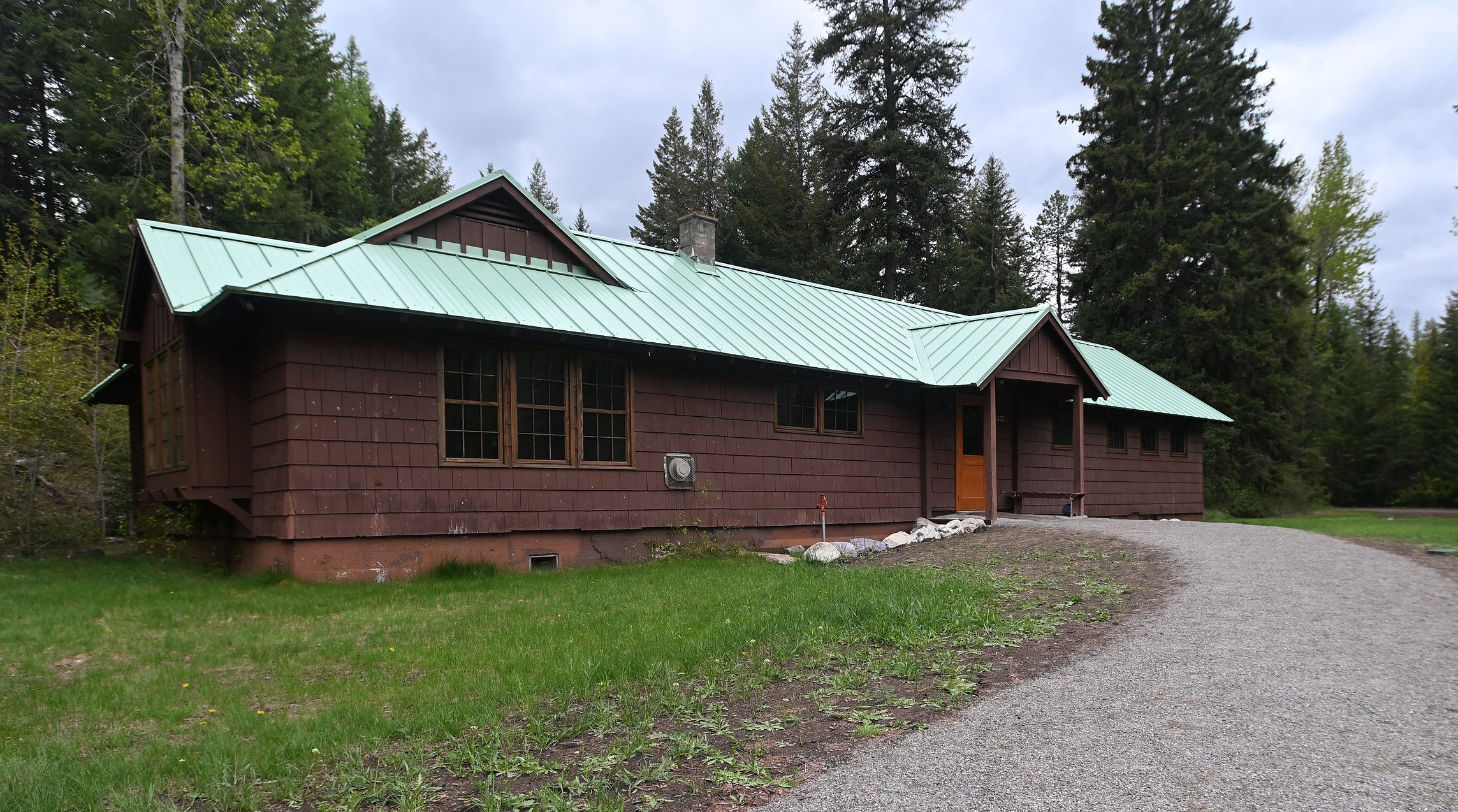Description
Humidity hung heavy in the air as a crowd gathered around the fire pit at Big Creek Education Center as evening fell. Beneath the woodsy odor of campfire smoke, a whiff of wet earth emerged. Storm clouds roiled across the mountaintops.
Despite the violent skies, Anthony Nelson smiled as he faced the May 16 gathering. This moment, celebrating the renovation of the Big Creek campus, had been years in the making. The threat of rain could do little to dampen the excitement.
The Glacier Institute has operated the Big Creek campus as a summer camp and field trip destination since 1989. Located on the banks of the North Fork of the Flathead River, the remote slice of forest offers ample opportunities to engage students in hands-on ecological lessons and outdoor activities. But by the time Nelson took up the mantle as the executive director of the Glacier Institute in 2020, years of use had left the campus riddled with what one board member called “bubble gum and duct tape fixes.”
Five years and $1.5 million worth of repairs later, Nelson stood with a plastic cup of sparkling cider in-hand, ready to toast to Big Creek’s future.
“There’s something about this place that’s kind of magnetic,” Nelson said as he lifted his drink. “It draws people back.”
THE U.S. Forest Service first developed the Big Creek campus in the early 1900s as a remote administrative hub and stopover for travelers riding between Columbia Falls and Polebridge. Rangers slept in seasonal log cabins until 1927, when the U.S. Forest Service constructed the first permanent building to serve as both a ranger’s station and staff housing. Over the next decades, a mess hall, workshop and bunkhouses were added.
In 1966, the campus was selected as the headquarters for the Flathead Interregional Fire Suppression Crew, one of the first so-called Hot Shot crews in the Pacific Northwest. The choice quickly proved fortuitous. The following summer, a fire broke out on Huckleberry Mountain, about a mile east and across the river from the Big Creek campus. Eastward winds and a web of hastily crafted fire lines spared the campus, though the blaze eventually burned more than 8,000 acres.
The Big Creek campus remained a hub for the region’s fire and forest management through the 1970s, but the need for remote outposts gradually waned as technology and transportation options improved.
By 1988, the U.S. Forest Service was eager to find a new use for the increasingly derelict campus. The Glacier Institute, meanwhile, needed a consistent location to host its growing roster of outdoor education programs. The two organizations signed a long-term lease agreement, catalyzing the campus’s transition into an environmental education center.
About 1,500 kids now visit the Big Creek campus each year, as part of either a school field trip or one of the Glacier Institute’s summer programs. The bunkhouses sleep about 40 visitors at a time, and most groups stay at the camp for two or three days.
During the day, the Glacier Institute’s educational staff use the surrounding woods as a living classroom to teach lessons on topics like stream ecology and botany. A typical evening involves the quintessential pastime of campfire stories and s’mores.
Mady Rigg recalled her own sixth grade field trip to Big Creek as a keystone in her appreciation for the natural world. Over a decade later, when she was offered the position of development director at the Glacier Institute, Rigg said she was excited to return to the campus. Even as an adult, she had kept “a big heart for the place.”
But the campus wasn’t quite like she remembered it. Some of the buildings’ floors were beginning to decay. The mess hall’s foundation appeared questionable, as did the ancient septic system.
“Structurally, it just wasn’t safe anymore,” said Rigg.
When Rigg joined the Glacier Institute in 2023, the organization had already launched a large-scale financial campaign to raise the funds necessary to renovate the Big Creek campus. While the U.S. Forest Service still owned the property and expressed support for the planned repairs, the federal agency had little money to spare. Instead, the $1.5 million renovation budget was pieced together with contributions from more than 300 donors.
DURING A tour of the Big Creek campus, Rigg pointed out the renovations completed over the past few years. The goal, she said, was to “toe the line” between preserving Big Creek’s unique history and preparing the campus to better meet the needs of students and visitors.
Throughout the campus, floors made with asbestos had been removed and replaced with hardwood, and several buildings featured new doors and windows to better seal them from the elements. The mess hall featured a new foundation and a basement with rooms for staff housing, a vermin-proof pantry and a walk-in refrigerator and freezer. In the two bunkhouses, locker room-style bathrooms were replaced with private gender-neutral rooms with accessible showers.
A new septic system was installed to better safeguard the nearby waterways from leaks. A handful of solar panels were added to the campus’s existing grid, reducing its reliance on a gas-powered generator.
A few tasks are still underway, including the installation of interpretive signs and modifications to the workshop, but the Glacier Institute announced the campus as fully operational last month.
“It’s been a fun few years of getting to give back to programs that were so impactful for me as a kid,” said Rigg of her role on the project.
On May 16, she joined about 60 other Glacier Institute staff, board members and supporters in a toast to the project’s successful completion. Afterwards, partygoers roasted hot dogs and marshmallows over a campfire and strolled the gravel paths that wound through the Big Creek campus to admire the renovations.
Suddenly, the shell of gray sky cracked. Guests scuttled for shelter beneath the building eaves and tree boughs as a deluge of rain poured from the clouds. Beneath the food tent, a woman chuckled and gestured towards the wood pile, where a group of children played, heedless to the change in weather.
“Remember when we didn’t care if we got wet,” the woman said.
“I liked when it rained,” said another woman in a red flannel shirt. “I liked to splash in the puddles.”
The rain offered a visual metaphor to the sentiment Anthony Nelson expressed during his toast earlier in the evening.
“This is where kids come to fall in love with the outdoors,” he said.
Reporter Hailey Smalley may be reached at 758-4433 or [email protected].
News Source : https://dailyinterlake.com/news/2025/may/25/big-creek-renovations-hit-high-water-mark-ahead-of-summer-season/
Other Related News
05/25/2025
Israeli strikes over the past 24 hours killed at least 38 people in Gaza including a mothe...
05/25/2025
GARDINER For the past 43 years hundreds of horses have marched from Gardiner to the Jardi...
05/25/2025
HARLOWTON - By now youre familiar with the phrase eat local but thats easier said than don...
05/25/2025
The US military spent more than 6 billion over the past three years to recruit and retain ...
05/25/2025














